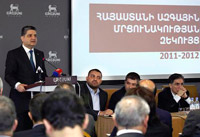Prime-minister Tigran Sargsyan participated in the fourth national awards ceremony and presentation of the report entitled “Armenian national competitiveness report 2011-2012: agenda for improvement of administration practices.”
The report was published by the Economy and Values research center and EV Consulting organizations. He report covers Armenia’s competitiveness potential and management practices in companies. The PM came up with speech and said that an important tradition had been originated in Armenia, which was the fact that presentations of such reports were being organized in participation with representatives from the government as well, which enabled all parties involved in the process to hold free and open discussion concerning the topics related thereto. According to Tigran Sargsyan, this means that the government attaches importance to the issue of competitiveness and believes that this is one of the most important factors of the economy. As we see, the government is really interested in this report. This attention is so much that even one of the welcoming pages of the report was written by Tigran Sargsyan, and the other one by professor Nicholas Bloom from the Stanford University. The reaction of the government and PM is very interesting. It is not a secret that the authorities are more open to those reports, which contain only positive messages. The past reports on the competitiveness factor have also been objective as they revealed the weaknesses, shortcomings and positive developments. This time the report contains positive messages too, but it also contains things that definitely the prime-minister would not like in consideration of the fact that elections are coming up. According to the report, the competitiveness factor was better in 2011 than in 2010. In 2011 Armenia moved up with six places in the list of the countries with competitiveness index and was in the 92nd place among 142 countries. “Armenia’s competitiveness index, which has been falling down since 2005, changed to positive in 2011 expressing the positive institutional tendencies. This can be a sign for change of the balanced situation. Generally the longer-term dynamics of competitiveness index reveals the negative factors in the economy, which result in ‘growth-competitiveness’ paradox. The aggressive economic growth in the country was guided by reduced competitiveness index. During the crisis period the rapid slump of economic activity did not have such impact on the competitiveness index.” This not only indirectly praises the policy of the incumbent government, but also contains indirect critics concerning the former ‘aggressive growth’ quality. The message in the report that points out on the negative factors of the government’s policy is the statement that the high share if low productivity sector in the GDP is one of the main shortcomings of the Armenian economy. “The first three sectors with high rate of employment (financial mediation services, mining and construction sectors) are the 9% of the country’s employment rate only,” writes the report. The report contains positive messages concerning the economic policy sectors which are usually criticized more. The section on foreign trade writes that even though the export is centralized, it improved significantly in 2011. The authors of the report assure that the state debt level is not dangerous – “The state debt management level is in manageable frames.” The report also writes that the reforms in the sectors of pensions and insurance markets are showing hope, have activated anti-monopolistic activities, etc. The best part of the report for the government is the section on crisis. The incumbent government and prime-minister have been criticized for late actions against the crisis, as well as ineffective activities and irrational spending of foreign debts. The report has divided these 12 years into phases, in which the first phase (2005-2008) is called insertion, and the second phase (2008-2010) was called “fire fighting”. This section describes the situation during the crisis. The report writes that Armenia’s economy was mostly unprepared for the international crisis and did not have responding mechanisms neither in the policy nor at market levels. There was no successful precedent of effective response to crisis in the world; this crisis was very large and there were no tools in the world to fight against this contagious sickness. “Instead of such tools the government used traditional tools such as monetary and tax and budget enlargement policy, as well as significant support to financial institutions,” writes the report reminding about the government’s remedies (creation of operative headquarter under the control of the prime-minister, creation of a state crediting institution, etc.). It is very interesting to see how the report describes the impact of those remedies. “The anti-crisis activities prevented the impacts of the crisis supporting recovering of the economy after a rapid slump. There were positive structural changes, including growth of production. In parallel with recovering of the world economy, the export started to recover as well. The inflation pressure was activated as well, threatening to deepen the wealthy living stagnation and increase inequality. The growth of corporative debt resulted in certain risks in the banking system.” Generally the report gives positive estimation of the government’s policy. The report also includes analysis on the third phase (2010-2011), which is entitled “Vision approaches drastic change”. The authors of the report have described this phase in the following way: “Transfer to more initiating and cooperation policy. The milestone of the policy is the cooperation between the state and private sectors and targeted sector for the purpose of supporting production and export-oriented policy.” The report also contains many shortcomings and gaps in the policy. For example, concerning competition the report writes that the tax and customs systems are still preventing development, the levels of incomes and consumption inequity continue to be high, Armenia is losing its priority in the rival of innovative competition, the state purchase policy does not stimulate economic development, etc. Definitely these negative things will not be published much in the media. As not all people have time and wish to read this report consisting of 101 pages, it will definitely be discussed and introduced in bright and colored lights.

